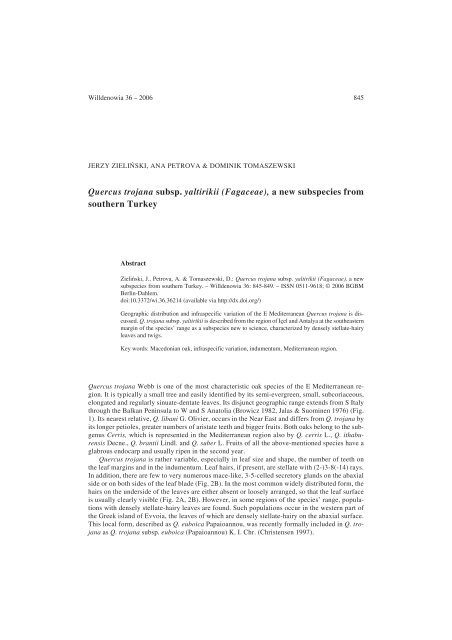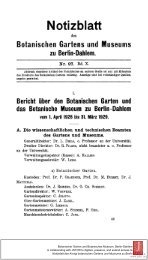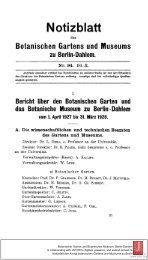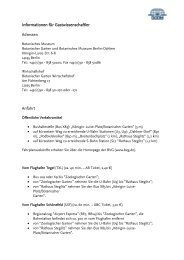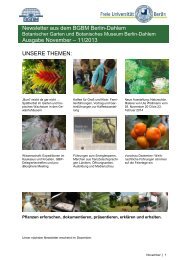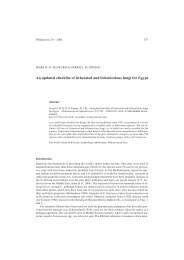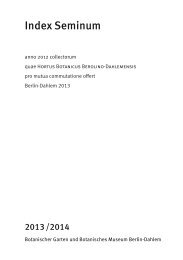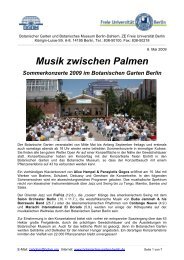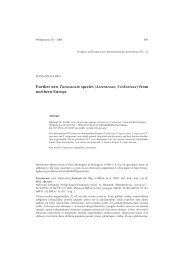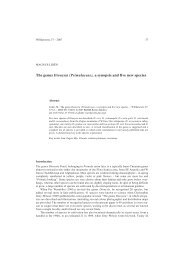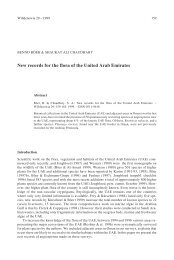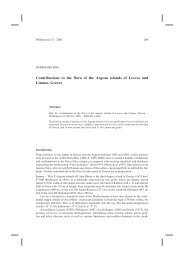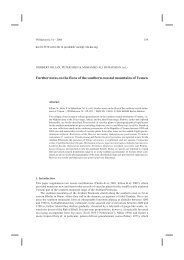Quercus trojana subsp. yaltirikii (Fagaceae), a new subspecies from ...
Quercus trojana subsp. yaltirikii (Fagaceae), a new subspecies from ...
Quercus trojana subsp. yaltirikii (Fagaceae), a new subspecies from ...
You also want an ePaper? Increase the reach of your titles
YUMPU automatically turns print PDFs into web optimized ePapers that Google loves.
Willdenowia 36 – 2006 845<br />
JERZY ZIELIOSKI, ANA PETROVA & DOMINIK TOMASZEWSKI<br />
<strong>Quercus</strong> <strong>trojana</strong> <strong>subsp</strong>. <strong>yaltirikii</strong> (<strong>Fagaceae</strong>), a <strong>new</strong> <strong>subsp</strong>ecies <strong>from</strong><br />
southern Turkey<br />
Abstract<br />
Zielioski, J., Petrova, A. & Tomaszewski, D.: <strong>Quercus</strong> <strong>trojana</strong> <strong>subsp</strong>. <strong>yaltirikii</strong> (<strong>Fagaceae</strong>), a <strong>new</strong><br />
<strong>subsp</strong>ecies <strong>from</strong> southern Turkey. – Willdenowia 36: 845-849. – ISSN 0511-9618; © 2006 BGBM<br />
Berlin-Dahlem.<br />
doi:10.3372/wi.36.36214 (available via http://dx.doi.org/)<br />
Geographic distribution and infraspecific variation of the E Mediterranean <strong>Quercus</strong> <strong>trojana</strong> is discussed.<br />
Q. <strong>trojana</strong> <strong>subsp</strong>. <strong>yaltirikii</strong> is described <strong>from</strong> the region of Içel and Antalya at the southeastern<br />
margin of the species’ range as a <strong>subsp</strong>ecies <strong>new</strong> to science, characterized by densely stellate-hairy<br />
leaves and twigs.<br />
Key words: Macedonian oak, infraspecific variation, indumentum, Mediterranean region.<br />
<strong>Quercus</strong> <strong>trojana</strong> Webb is one of the most characteristic oak species of the E Mediterranean region.<br />
It is typically a small tree and easily identified by its semi-evergreen, small, subcoriaceous,<br />
elongated and regularly sinuate-dentate leaves. Its disjunct geographic range extends <strong>from</strong> S Italy<br />
through the Balkan Peninsula to W and S Anatolia (Browicz 1982, Jalas & Suominen 1976) (Fig.<br />
1). Its nearest relative, Q. libani G. Olivier, occurs in the Near East and differs <strong>from</strong> Q. <strong>trojana</strong> by<br />
its longer petioles, greater numbers of aristate teeth and bigger fruits. Both oaks belong to the subgenus<br />
Cerris, which is represented in the Mediterranean region also by Q. cerris L., Q. ithaburensis<br />
Decne., Q. brantii Lindl. and Q. suber L. Fruits of all the above-mentioned species have a<br />
glabrous endocarp and usually ripen in the second year.<br />
<strong>Quercus</strong> <strong>trojana</strong> is rather variable, especially in leaf size and shape, the number of teeth on<br />
the leaf margins and in the indumentum. Leaf hairs, if present, are stellate with (2-)3-8(-14) rays.<br />
In addition, there are few to very numerous mace-like, 3-5-celled secretory glands on the abaxial<br />
side or on both sides of the leaf blade (Fig. 2B). In the most common widely distributed form, the<br />
hairs on the underside of the leaves are either absent or loosely arranged, so that the leaf surface<br />
is usually clearly visible (Fig. 2A, 2B). However, in some regions of the species’ range, populations<br />
with densely stellate-hairy leaves are found. Such populations occur in the western part of<br />
the Greek island of Evvoia, the leaves of which are densely stellate-hairy on the abaxial surface.<br />
This local form, described as Q. euboica Papaioannou, was recently formally included in Q. <strong>trojana</strong><br />
as Q. <strong>trojana</strong> <strong>subsp</strong>. euboica (Papaioannou) K. I. Chr. (Christensen 1997).
846 Zielioski & al.: <strong>Quercus</strong> <strong>trojana</strong> <strong>subsp</strong>. <strong>yaltirikii</strong> <strong>from</strong> southern Turkey<br />
Fig. 1. General geographic distribution of <strong>Quercus</strong> <strong>trojana</strong> – 1 = <strong>subsp</strong>. <strong>trojana</strong>; 2 = <strong>subsp</strong>. <strong>yaltirikii</strong>;<br />
3 = <strong>subsp</strong>. euboica. – Distribution data according to Jovancevic (1965), Jalas & Suominen (1976), Browicz<br />
(1982), Hedge & Yaltirik (1982), Yaltirik (1984), Boratyoski & al. (1992), Christensen (1997), Mucina &<br />
Dimopoulos (2000) and Gussev & al. (2005).<br />
Another distinctly hairy variant of <strong>Quercus</strong> <strong>trojana</strong> occurs at the southeastern margin of the species’<br />
range, in the region of Içel and Antalya in central S Turkey (Fig. 3). In contrast to <strong>subsp</strong>.<br />
euboica, these populations consist of small trees with densely hairy branchlets and leaves with hairs<br />
present on both sides of the blade. (Fig 2D). These forms, previously discussed by Hedge & Yaltirik<br />
(1982) in Flora of Turkey, were also collected in 1991 in the same region by a group of dendrologists<br />
<strong>from</strong> the Institute of Dendrology in Kórnik, Poland. Hedge & Yaltirik (1982) suggest that the dense<br />
indumentum may be a result of introgression with Q. ithaburensis <strong>subsp</strong>. macrolepis (Kotschy)<br />
Hedge & Yalt. However, apart <strong>from</strong> the densely hairy leaves, the above-mentioned specimens do not<br />
differ <strong>from</strong> Q. <strong>trojana</strong>. In our opinion they represent a peculiar extreme variant of this oak that merits<br />
treatment as a separate <strong>subsp</strong>ecies. We propose the epithet <strong>yaltirikii</strong>, in honour of Faik Yaltirik, Professor<br />
of Botany at the Istanbul University and leading expert of the Turkish woody flora.<br />
<strong>Quercus</strong> <strong>trojana</strong> <strong>subsp</strong>. <strong>yaltirikii</strong> Ziel., Petrova & D. Tomaszewski, <strong>subsp</strong>. nov.<br />
Holotype: S Turkey, distr. Içel, between Haci Ahmetli and Çukurba8, just near Çukurba8, 18-<br />
20 km NNE of Mut, 1200 m, stony-clayey slope, edge of Pinus brutia forest, 31.5.1991, Boratyoski,<br />
Browicz & Zielioski 6863 (KOR 25094) – Fig. 2D, 3.<br />
Arbor humilis. Rami juveniles sat dense stellulato-pubescentes. Folia supra laxe stellulatopubescentia,<br />
subtus dense pilis stellulatis tecta, cinerea.<br />
Small tree; annual branchlets distinctly stellate-hairy; buds brown, ciliate. Leaves up to 7(-8) cm<br />
long, to 2.5 cm wide, ovate-lanceolate to oblong-lanceolate, rounded or shallowly cordate at base,<br />
acute at apex, loosely to densely stellate-hairy above, with up to 11(-13) mucronate teeth, densely<br />
stellate-hairy beneath, grey. Stipules narrow, early caducous. Petioles 3-5 mm long, hairy. Cupule<br />
scales appressed or patent.
Willdenowia 36 – 2006 847<br />
Fig. 2. <strong>Quercus</strong> <strong>trojana</strong>, SEM photographs of the abaxial leaf surface – A: <strong>subsp</strong>. <strong>trojana</strong> (<strong>from</strong> KOR 26542);<br />
B: <strong>subsp</strong>. <strong>trojana</strong>, a form with numerous secretory glands (<strong>from</strong> KOR 26545); C: <strong>subsp</strong>. <strong>trojana</strong>, glands secretion<br />
visible (<strong>from</strong> KOR 12068); D: <strong>subsp</strong>. <strong>yaltirikii</strong> (<strong>from</strong> the holotype, KOR 25094). – Scale bars: A-B,<br />
D = 100 µm, C = 50 µm; photographs by M. Gawlak.<br />
Additional specimens seen (paratypes). – S Turkey, distr. Içel, near Abanoz, by the road to Ermenek,<br />
small meadow among rocks, 29.5.1991, Boratyoski, Browicz & Zielioski 6780 (KOR 31026);<br />
Boratyoski, Browicz & Zielioski 6886 (KOR 25063); distr. Antalya, Geyik Da8lari, 1500 m, Abies<br />
cilicica-Pinus nigra forest on calcareous rocks, frequently, 5.8.2005, Boratyoski & Boratyoska<br />
TU-05/32 (B, KOR 44631). – See also Hedge & Yaltirik (1982: 680).<br />
The taxonomy of <strong>Quercus</strong> <strong>trojana</strong> is as follows:<br />
<strong>Quercus</strong> <strong>trojana</strong> Webb in Gard. Mag. & Reg. Rural Domest. Improv. 15: 590. 1839<br />
a. <strong>subsp</strong>. <strong>trojana</strong><br />
= <strong>Quercus</strong> macedonica A. DC., Prodr. 16(2): 50. 1864<br />
b. <strong>subsp</strong>. euboica (Papaioannou) K. I. Chr. in Strid & Tan, Fl. Hellen. 1: 45. 1997 ≡ <strong>Quercus</strong><br />
euboica Papaioannou in Compt. Rend. Acad. Athènes 23: 336. 1949<br />
c. <strong>subsp</strong>. <strong>yaltirikii</strong> Ziel., Petrova & D. Tomaszewski<br />
Key to the <strong>subsp</strong>ecies of <strong>Quercus</strong> <strong>trojana</strong><br />
1. Leaves glabrous on both sides or sparsely stellate-hairy beneath . . . . . <strong>subsp</strong>. <strong>trojana</strong><br />
– At least the abaxial leaf surface densely covered with stellate hairs. . . . . . . . . . 2<br />
2. Leaves stellate-hairy on both sides; adult annual branchlets distinctly stellate-hairy; small<br />
tree (central S Turkey) . . . . . . . . . . . . . . . . . . . . . <strong>subsp</strong>. <strong>yaltirikii</strong><br />
– Leaves glabrous above; adult branchlets glabrous or sparsely hairy; shrub (Greece,<br />
Evvoia) . . . . . . . . . . . . . . . . . . . . . . . . . . . . <strong>subsp</strong>. euboica
848 Zielioski & al.: <strong>Quercus</strong> <strong>trojana</strong> <strong>subsp</strong>. <strong>yaltirikii</strong> <strong>from</strong> southern Turkey<br />
Fig. 3. <strong>Quercus</strong> <strong>trojana</strong> <strong>subsp</strong>. <strong>yaltirikii</strong> – holotype specimen Boratyoski, Browicz & Zielioski 6863 (KOR<br />
25094). – Scale bar = 5 cm; photograph by M. Dziurla.<br />
Acknowledgements<br />
We are grateful to Dr Piotr Kosioski for technical help in preparation of the map of <strong>Quercus</strong><br />
<strong>trojana</strong>, to Mrs Magdalena Gawlak for the SEM photographs and to Mr Miros5aw Dziurla for the<br />
photograph of the holotype. We also thank Dr Mark G. Tjoelker, College Station, Texas, for linguistic<br />
correction and the anonymous reviewer for valuable comments on the manuscript.<br />
References<br />
Boratyoski, A., Browicz, B. & Zielioski, J. 1992: Chorology of trees and shrubs in Greece. –<br />
Poznao & Kórnik.
Willdenowia 36 – 2006 849<br />
Browicz, K. 1982: Chorology of trees and shrubs in south-west Asia and adjacent regions 1. –<br />
Warszawa & Poznao.<br />
Christensen, K. I. 1997: <strong>Quercus</strong> L. – Pp. 42-50 in: Strid, A. & Tan, K. (ed.), Flora hellenica 1.<br />
– Königstein.<br />
Gussev, C., Vulchev V., Ganeva, A. & Gyosheva, M. 2005: Flora, vegetation, macromycetes<br />
and habitats in the maintained reserve “Gabra” (Vlahina Mt). – Pp. 89-109 in: Chipev, N. &<br />
Bogoev, V. (ed.), Biodiversity, ecosystems and global change. First Scientific Ecological<br />
Conference. – Sofia.<br />
Hedge, I. & Yaltirik, F. 1982: <strong>Quercus</strong> L. – Pp. 659-683 in: Davis P. H. (ed.), Flora of Turkey<br />
and the East Aegean Islands 7. – Edinburgh.<br />
Jalas, J. & Suominen, J. (ed.). 1976: Atlas Florae Europeae 3. – Helsinki.<br />
Jovancevic, M. 1965: Rasprostranjenje, variabilitet i sistematica crnog cera (<strong>Quercus</strong> macedonica<br />
A. DC.) u Jugoslavii. – Anali Eksper. Sumarstvo JAZU 3: 271-448.<br />
Mucina, L. & Dimopoulos, P. 2000: New locality of <strong>Quercus</strong> <strong>trojana</strong> <strong>subsp</strong>. euboica (<strong>Fagaceae</strong>)<br />
– Fl. Medit. 10: 261-264.<br />
Yaltirik, F. 1984: Turkiye meseleri. Yenilik Basimevi. – Istanbul.<br />
Addresses of the authors:<br />
Jerzy Zielioski & Dominik Tomaszewski, Polish Academy of Sciences, Institute of Dendrology,<br />
Parkowa 5, 62-035 Kórnik, Poland; e-mail: dominito@man. poznan.pl<br />
Ana Petrova, Bulgarian Academy of Sciences, Institute of Botany, Acad. G. Bonchev Street, bl.<br />
23, 1113 Sofia, Bulgaria.


